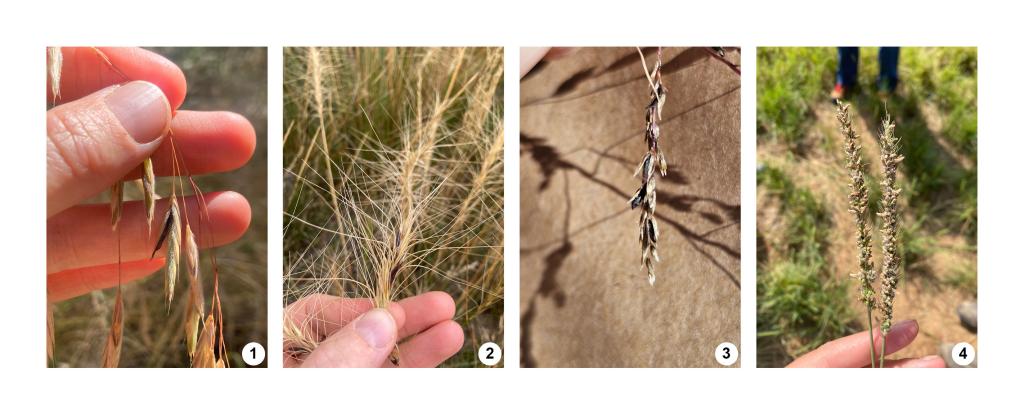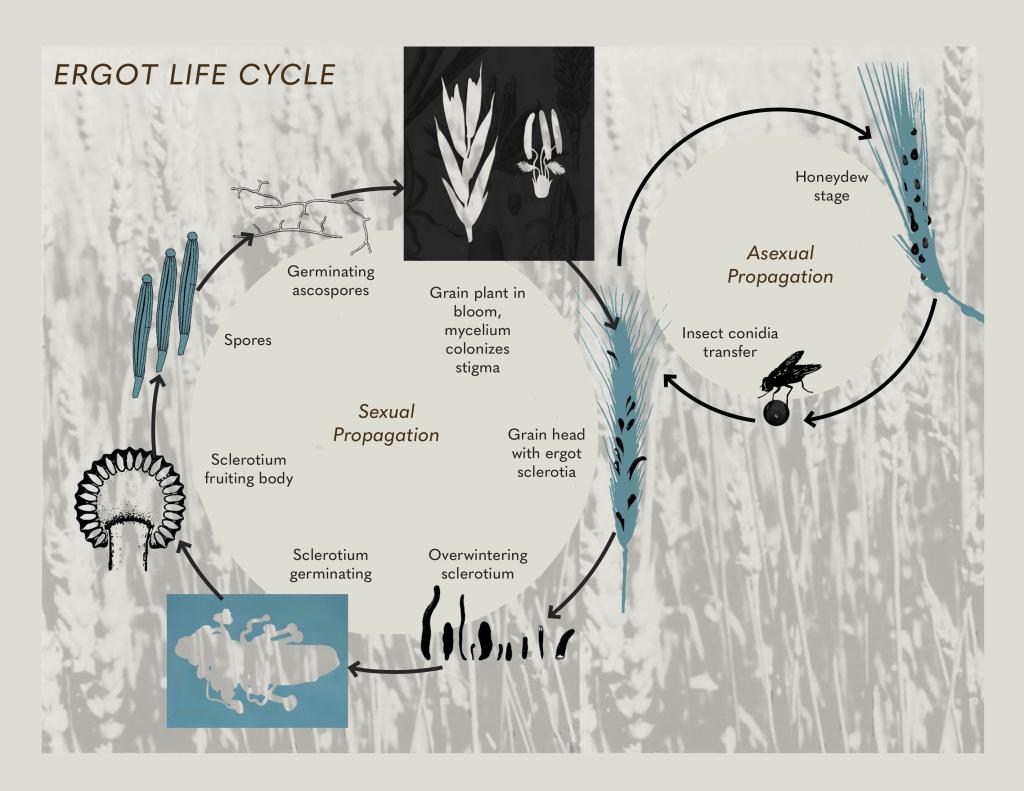By Hollis Moore, February 2024
During the 2023 field season, Southwest Seed Partnership (SWSP) seed collectors noticed higher than usual ergot prevalence on grass species throughout the Southwest. And in 2021, one of our farm fields even had an outbreak of ergot. These reports had us considering: is it appropriate to collect from a population with ergot present on some individuals, even if you avoid plants with signs of the disease? Can undetectable levels of ergot present in a collection taint the entire collection? Can ergot spread to other collections in a shared storage place? If wild collected seed is potentially infected with ergot, does that mean that the production field will have a higher likelihood of infestation if the environmental conditions favor the pathogen? Or is ergot already present in the soil at seed farms? While it was possible to clean the ergot sclerotium out of the seed lot, we still wondered: Is it safe to use this seed in restoration projects? Further, if this was present in our field, it must also occur in other production fields. Would we know if the seed we are buying came from infected fields? This prompted a deeper dive into the literature to untangle our lingering questions.
Ergot is a fungal pathogen in the genus Claviceps. Claviceps purpurea is the most widespread species in this group, infecting over 400 grass species in temperate regions throughout the world. Ergot makes appearances throughout human history as a crop pathogen, tainting rye, sorghum, millet, and wheat crops and consequently causing outbreaks of human illness (i.e. Salem Witch Trials and St. Anthony’s Fire). Famously, Dr. Albert Hoffman accidentally discovered and dosed himself with an ergot-derived alkaloid called Lysergic acid diethylamide (aka LSD) in 1943. Undoubtedly, this substance has had lasting impacts on art, music, and culture in the 20th century.
Ergot infection initially occurs when grasses are flowering. Ascospores mimic pollination by landing on the stamen and colonizing unpollinated ovaries; replacing the seed or grain with a sclerotium (a mycelial ergot kernel). Flowers are only susceptible to infection for a few days before pollination. After pollination, the flower becomes immune to ergot infection. Floral morphology is an important factor contributing to susceptibility. Species with less exposed stigmas are not as susceptible. Cool and wet springs seem to increase infection across the board by delaying pollination. In these conditions, flowers are open for a longer period and therefore more susceptible. Additionally, cool and wet weather promotes fungal spores. Sclerotium present in the soil releases spores as raindrops fall on them, allowing the spores to find their way to susceptible flowers.
In 2023 our field crews identified ergot on many grass species throughout New Mexico’s diverse ecoregions. Our crews were careful not to collect seed from ergot-infected plants. Broken sclerotia pieces within a collection bag may transfer ergot alkaloids to uninfected seeds and even outlast the seed in storage. The good news is that ergot propagules can often be cleaned out of seed collections and harvests because the sclerotia is easy to identify and lighter than the seeds, but machines used to separate the sclerotia should be well-cleaned as a precaution. We avoid introducing the pathogen to seed storage/cleaning facilities and production fields.
Farming seeds infected with ergot may adversely impact growers’ fields. The sclerotia overwinters in soils and limits what subsequent species could be grown in that field. Treatment methods for ergot-infected fields include burning after harvest, deeply plowing soils, limiting bare soils and cover cropping fields with non-susceptible crops, managing weeds and volunteer plants susceptible to ergot, and use of fungicides and biocontrols. Seed yields may be impacted by ergot because the infection itself reduces some species’ seed production and heavily contaminated seed lots are not viable. Curiously, some species may reproductively compensate or overcompensate and increase yield. For example, ergot infection in northern California native Spartina reduces seed yield in most cases, but doesn’t affect or even increases yield in other species.
We may not know if we are buying seeds for restoration that came from an infected production field; however, using potentially infected seeds in restoration projects is not expected to negatively impact restoration projects. Some research demonstrates that the cost of ergot infection to plants is low. Plants may tolerate minor infections by mitigating the adverse effects. In some ecological situations, ergot infection demonstrates the possibility of conditional defense mutualism. Ergot may protect plants and their neighbors from grazing mammals that avoid the infected plants. Other related fungus species that produce ergot alkaloids are known to benefit hosts by reducing herbivory and seed predation. If known ergot-infected seed is detected in restoration projects, we advocate for post-seeding monitoring of ergot propagules on the seeds of mature plants to better understand how ergot spreads.
Ergot is a fascinating fungal infection affecting many grass species, with a complex cultural and biological history. The pathogen’s impacts are less dramatic in the native seed industry than in the food industry, but we lack research on the subject and still have a lot to learn. However, we do know that we should be on the lookout for this pathogen when we have a cool, wet spring! The best method to prevent ergot is to avoid collecting seeds from infected plants. Yet, ergot will always play a role in native plant systems, and we continue to explore our questions surrounding ergot management in cleaning, production, and restoration.


